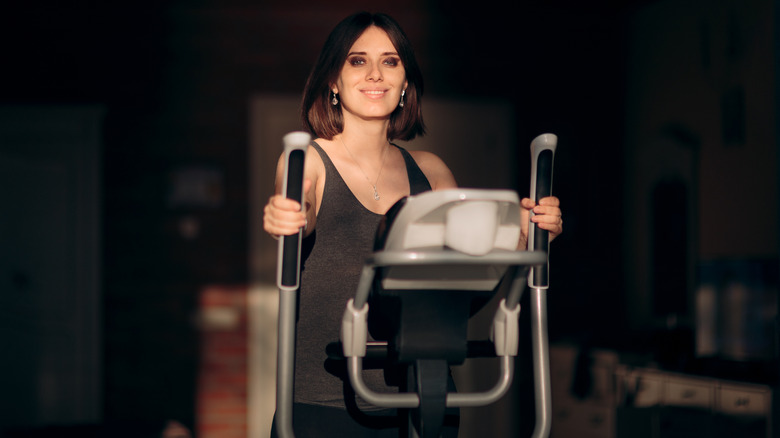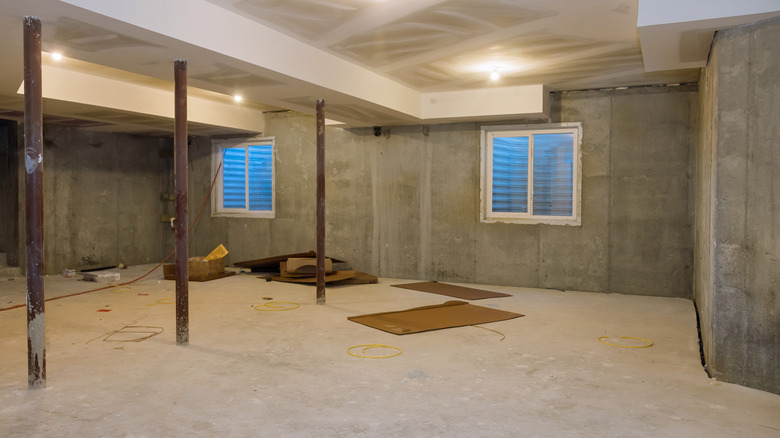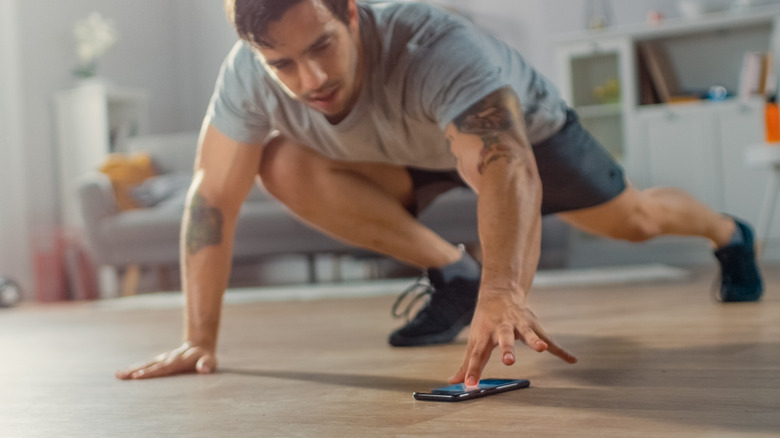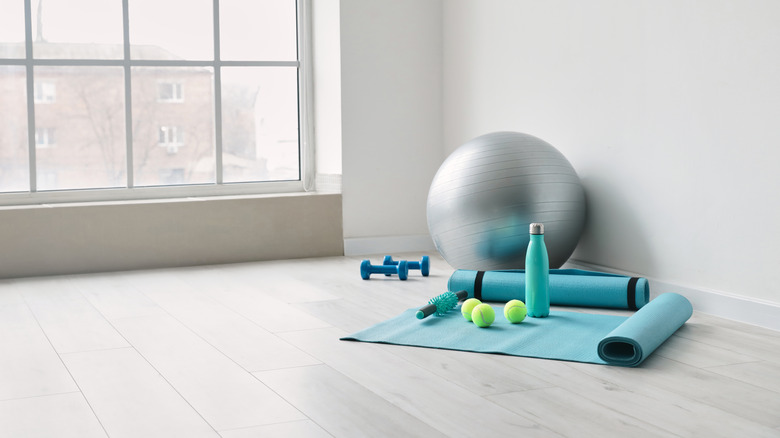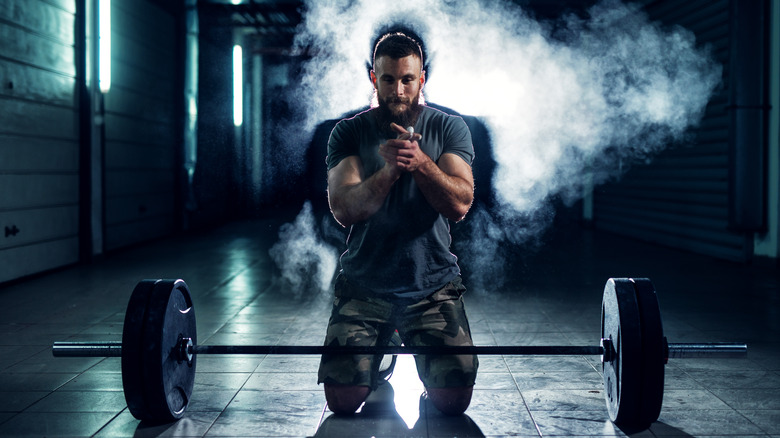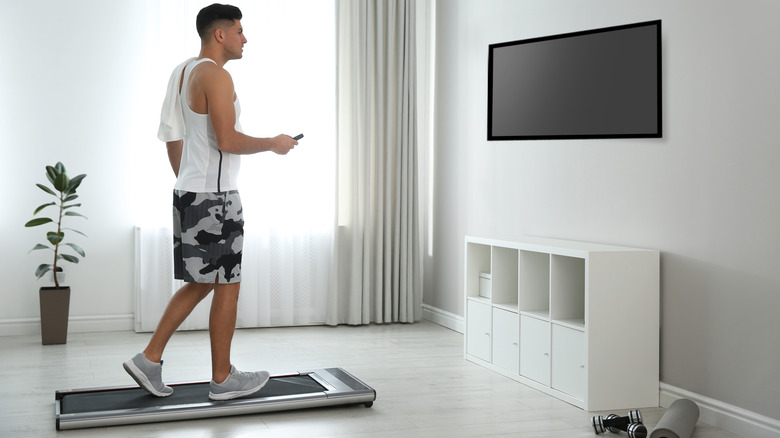The Best Way To Make Your Basement Feel Like The Perfect Workout Room
Maybe you like working up a sweat without an audience, or maybe you don't like waiting for machines or wondering whose grimy mitts have been all over the weights you're about handle. And maybe — just maybe — it'll be harder to skip the gym if it's a mere flight of stairs away in your own basement.
Whatever the reason, working out at home is as popular as it's ever been, perhaps in part because the COVID-19 pandemic ensured that the only way you were going to get exercise safely was to do it as far away from other people as possible. The trend is so firmly entrenched that businesses like Torque Fitness will take your specifications and design a 2D or 3D model of your dream gym for you.
But not everyone wants or can afford such expert advice. So if you're looking to transform your basement into a home gym, we have a few important guidelines that should put you on the road to achieving your fitness goals downstairs.
Find your workout space
Begin by taking inventory of your basement space. How much light is available? Does your floor need padding? How tall are the ceilings? That becomes essential when selecting equipment. How well ventilated is the room? Is there mold present? The last thing you want to do is damage your health while trying to improve your physique.
Second, it's just as important to create a space you want to visit, rather than just a spot where all your gear lives. The experts at BarBend suggest that the first step to creating a workable gym at home is to dedicate space about the size of the typical deadlift platform (they suggest an area no smaller than 4 by 8 feet). Even though that doesn't sound like much in terms of raw area, it is really all that's needed to perform most of the lifting exercises the professionals recommend.
Once you've identified a workable space and made sure it's both sturdy and clean, you're ready to assess what you wish to accomplish.
Decide on your set up
Reflect on your favorite gym set-up or one that you might consider ideal. Move in your mind around the room as if you're completing a circuit. Think first in terms of weight and machines like the Smith machine and a bench where you can lay, kneel or sit to hoist what it is you're trying to lift during any given exercise. With a Smith machine, you can do squats, shoulders, bench press, back work, and modified arm workouts per LiveStrong.
Next, consider whether or not you need a treadmill or an elliptical machine. Maybe, if you live in a spot where spring arrives early and summer leaves late, you'll be happy enough exercising outside, either running, biking, or jumping rope. The professionals at Live Healthy say that you're pretty much burning the same number of calories on an elliptical as you would be running outside. But if it's cold often or rains constantly, you might be better off with a machine that won't allow you to skip your cardio routine.
Stick to your budget
Remember the old saying, "How do you eat an elephant?" The answer is "One bite at a time." In the context of a home gym, that means assessing your fitness routine with an eye to your budget. Start with what you'll need based on your health and goals, keeping in mind that you can buy some equipment used and add pieces as you progress.
Strong Home Gym recommends looking for sale items (and in fact, they have a page called Black Friday Gym Equipment to help you find pieces large, small, and in-between) and buying second-hand whenever possible. Just like any other business, gyms are opening and closing all the time, and some of that equipment is either recent, brand new, or fairly indestructible. Think of hand-held iron weights, for example. They're pretty durable and appear almost without any bells or whistles that might make them vulnerable to damage. You could save, if you'll pardon the pun, tons.
Set up your home workout room
Whether you're renting or own, you don't want to drop weights or heavy machines to destroy your floor, right? The Strategists recommends buying interlocking rubber flooring pieces that assemble just like a puzzle and will protect the floor from most kinds of damage.
If you're looking to spend a significant amount of time here (which you'll need if you're looking for real and lasting results), you'll want to make sure that the room is adequately ventilated and that the space has the kind of lighting you really want. Some prefer the boxing gym ambiance depicted above. Others want that ballet-class illumination that makes you feel like it's the best-lit room in town, per Think Tank Home.
Speaking of which, you know those floor-to-ceiling mirrors you'll see in dance rehearsal rooms? They're not there for show. They're there so that the dancers can check their form and synchronicity. You'll want some form of a mirror for exactly the same reason. Without a mirror, you can't tell if you're performing an exercise correctly. However, if you don't want a mirror dominating the room, try mounting a rounded security mirror or two in the upper corners of your gym. They're less obtrusive and will give you similar results.
Install some entertainment
Lastly, consider your mood. What will motivate you to want to be here more often? For many, the idea of having a flatscreen and a decent sound system is precisely the pampering touch, per Think Tank Home. A flatscreen will give you access to movies, news, and sports you can watch while doing cardio, and if you're someone who likes workout videos, your flatscreen provides you with a virtual coach and motivator.
Some will want an actual locker or a steamer trunk where they can store lighter weights, bands, and clips. Others prefer a corner water cooler to not only give you a quick way to quench your thirst but send out serious "you're at the gym" vibes as well.
Think: Is there anything else you can recall liking about a professional gym that you could bring home? Kaise West recommends a small dorm-sized refrigerator with cold towels as the ultimate way to end a workout. Most of them can store a number of towels while still having room for water bottles, caffeine-packed cold brews, or Red Bull.
